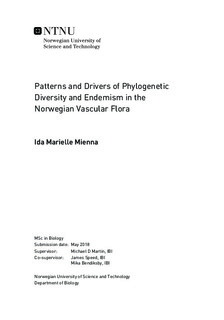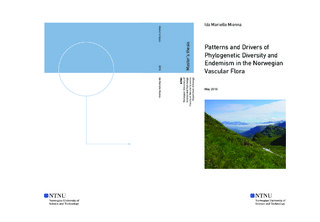| dc.description.abstract | Biodiversity is commonly measured as the local abundance of discrete species. This approach fails to incorporate evolutionary relationships among species and gives an incomplete picture of the diversity in a given region. Recently developed methods for spatial phylogenetics combine species occurrence datasets with molecular phylogenetic data to recover information about the spatial distribution of phylogenetic diversity and endemism across a geographic region. In this study, we applied these methods on vascular plants across Norway, a region that was covered by the Fennoscandian ice sheet until about 10 kyr BP. Our primary aim was to test whether patterns of phylogenetic diversity (PD) and phylogenetic endemism (PE) for 1238 native vascular plant species are non-randomly distributed across Norway and to seek causal mechanisms for the revealed patterns. A multi-locus concatenated alignment was produced using a combination of GenBank data and newly produced sequence data from herbarium specimens, and a corresponding phylogenetic hypothesis was inferred. We combined this data with occurrence data from GBIF, and then calculated PD, PE, relative phylogenetic diversity (RPD), and relative phylogenetic endemism (RPE). To assess areas of statistical significance we performed a spatial randomisation of these indices. To determine if PD outlier regions are associated with various environmental explanatory variables, we performed pairwise linear correlation analyses. We also performed range-weighted turnover analyses and compared these maps with previous studies on vegetation zones in Norway. Our results revealed significantly high PD and RPD (phylogenetic overdispersion) along the coast of southern Norway and significantly low PD and RPD (phylogenetic clustering) in the mountainous areas. The best fitted statistical models showed that the PD pattern could best be explained by temperature, time since last glaciation cover, and topographic heterogeneity. For PE and RPE, we found a concentration of short restricted branches (neo-endemics) in northern Norway, and a mix of short and long restricted branches (both neo-endemics and paleo-endemics) on the coast of southern Norway, with temperature inferred as a likely driver for the revealed patterns. The range-weighted turnover analyses showed an evolutionary signal in the way the flora is distributed. This study emphasizes the importance of incorporating evolutionary relationships between species to see patterns of diversity and endemism that would normally not be seen by examining species diversity alone. Moreover, it shows that spatial phylogenetics can be meaningfully applied to a region of short evolutionary history as opposed to previous studies restricted to regions with long evolutionary history (e.g. Australia and California). | |

